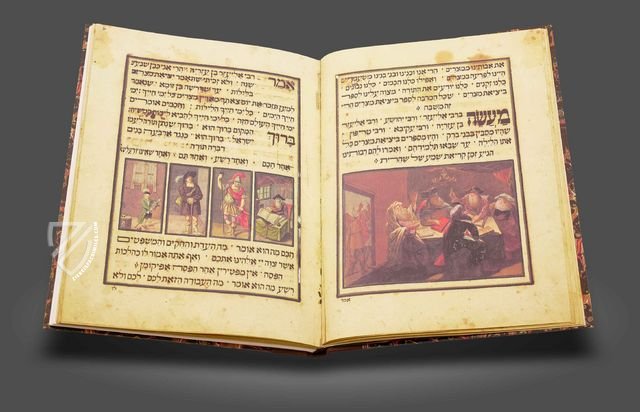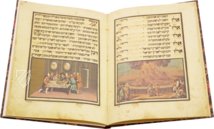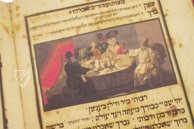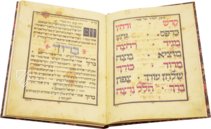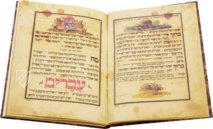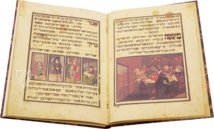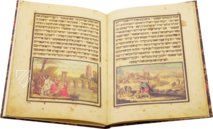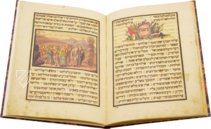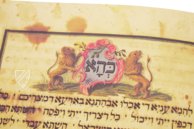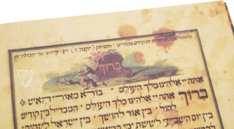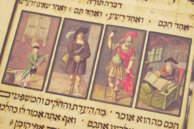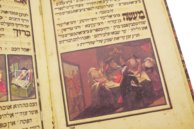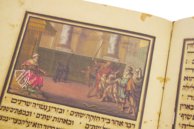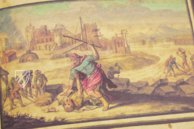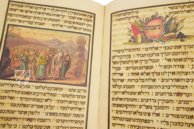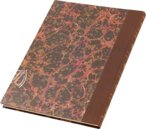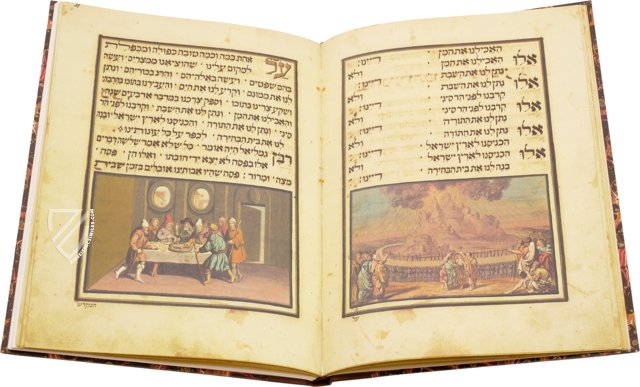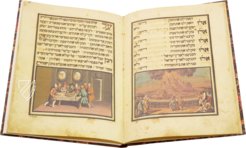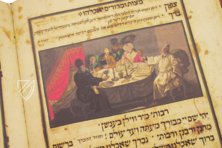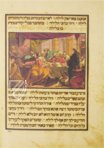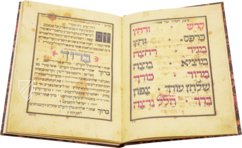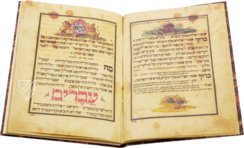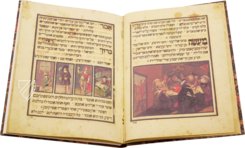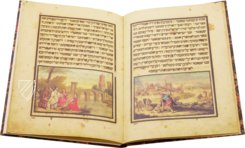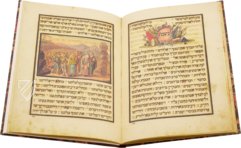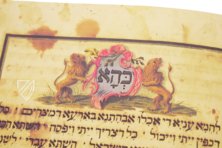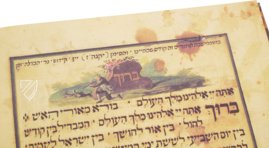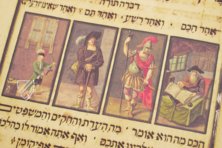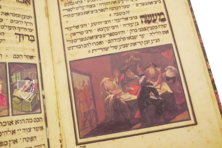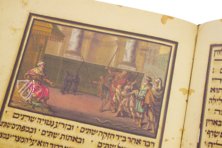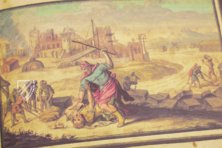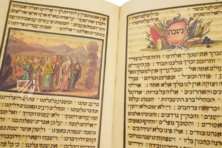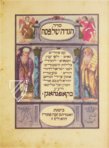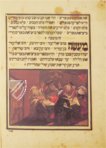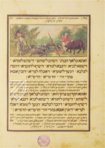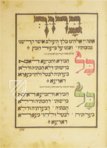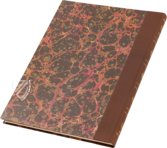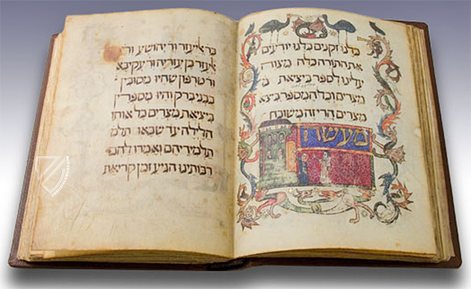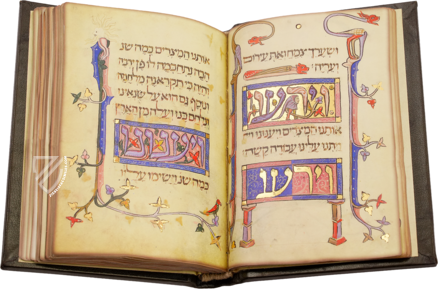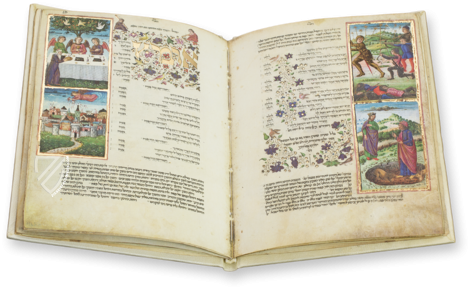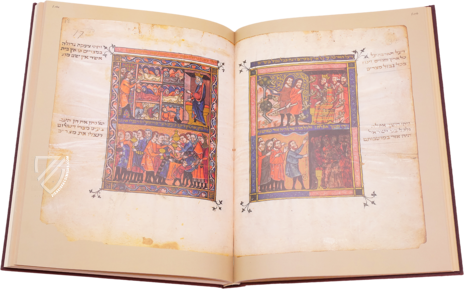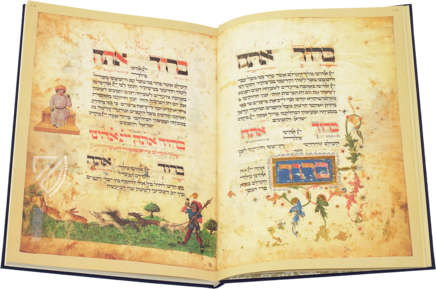Darmstadt Pessach Haggadah
(1,000€ - 3,000€)
Passover Seder is one of the most important Jewish celebrations, as it serves as an annual reminder of the crucial experience of the liberation of the people of Israel from Egyptian bondage and deliverance into the Promised Land. The significance of this feast day gave rise to a distinct book genre that combines the canonical stories with the associated psalms, hymns and instructions: the Passover Haggadah. In contrast to the Torah, the Haggadot could actually be illuminated. It is not unusual, but little known, that even three centuries after the invention of printing, such Haggadot were still being created by hand for this occasion. Written and artistically illuminated in 1769 in Copenhagen by Yehuda Leib ben Eliyya Ha-Cohen, the Darmstadt Pessach Haggadah is a particularly splendid, Baroque example of such a religious manual. Its miniatures can be read like small canvas paintings reflecting the cosmopolitan everyday life of the large and wealthy Jewish community in Copenhagen and are unusually strongly oriented towards European Christian art in terms of their style.
Darmstadt Pesach Haggadah - Codex Orientalis 7
The Darmstadt Pesach Haggadah, made in 1769 in Copenhagen, was both written and artfully decorated by Yehuda Leib ben Eliyya Ha-Cohen. Its illustrations of the relevant text passages represent ritual, biblical and eschatological aspects of liturgy. The miniatures by Yehuda Leib Ha-Cohen resemble small paintings and illustrate topics from the Pesach-Haggadah with great enthusiasm for details and precision, while also providing an insight into contemporary life.
The Magical Atmosphere of Jewish Illumination
The Pesach Haggadah, Hebrew for “Passover Narration”, provides the liturgical chronology of a Jewish religious meal held before the commencement of the Passover festival. Like the Bible and the Mahzor, it is among the most eminent illustrated Jewish religious manuscripts, since the Torah was never embellished with pictures. During the 18th century, the Pesach-Haggadah was virtually rediscovered by the arts, particularly by Danish artists working predominantly on this subject. The fact that in modern times, long after the invention of print, books – among them Jewish liturgical texts – were still copied by hand and lavishly decorated with the greatest care is hardly known, but impressively documented in this manuscript.
A Danish Haggadah
The rise of Jewish communities in Denmark goes back to the 17th century when King Christian IV encouraged Jews to move there for economic and political reasons. One of the larger communities was Copenhagen, with approximately a hundred thousand members. This community offered a cosmopolitan atmosphere and a wide range of cultural and economic activities. The Jewish population in Denmark lived in relative peace and prosperity due to the flourishing economy, which also provided a basis for numerous artistic commissions. Jewish scribes and painters thus discovered a favorite in the Pesach-Haggadah as an object for exquisite decoration.
A Liturgical Book for Passover
The Pesach-Haggadah commemorates the liberation of the people of Israel from servitude in Egypt and the Exodus to the Promised Land, the main intention being to pass on this message of liberation from one generation to the next, as "every person in whatever period they live has the obligation to consider themselves as being part of the great exodus from Egypt". The prospect of final deliverance is drawn from a messianic perspective. Passover begins on the 14th day of the month of Nisan, i.e. on the first full moon in spring, and lasts for eight days. At night, every family has their Passover lamb and unleavened bread (matzah), bitter herbs, and wine. Over the years, a fixed order (Seder) was established for this religious meal, according to which the liturgy was held. The basic form of this order is about a thousand years old. It was later compiled in a small book called Pesach-Haggadah. This book comprises biblical verses, hymns and Psalms, and records of religious customs. The head of the family reads it on the first and second evenings of Passover. As this happens during the ceremony and the meal, most manuscripts show marks of use, such as stains of wine.
Yehuda Leib ben Eliyya Ha-Cohen
The scribe and painter Yehuda Leib Ha-Cohen was born in Lissa, Poland. We know of two Haggadot that he produced in Denmark, the Darmstadt Codex from the year 1769 and a second one from 1779. Jewish illuminators have, as a rule, always worked in a very traditional manner. In contrast to his colleagues, Yehuda Leib was primarily concerned with European artistic creation, particularly with the Danish tradition and acquired a new painting style bridging the gap between the Baroque–Rococo and the classical periods. He was clearly inspired by other works, such as the Icones Biblicae by Matthäus Merian and the Haggadot of Amsterdam. He was also influenced by the etchings of Daniel Nikolaus Chodowiecki. Leib’s landscapes remind us of pictures from the French classical period and his architecture of the Baroque buildings in Copenhagen, while his interior scenes are conversation pieces typical of the Rococo. His nuances in effects of light and shade conjure up a magical atmosphere. In spite of his having been influenced by other artists, Leib developed an innovative style of his own, which makes his pictures truly unique.
Codicology
- Alternative Titles
- Darmstadt Pessah Hagada
Pessach-Haggadah
Darmstädter Pessach-Haggadah
Seder Hagadah shel Pesaḥ - Size / Format
- 52 pages / 34.0 × 25.0 cm
- Origin
- Denmark
- Date
- 1769
- Epochs
- Style
- Language
- Illustrations
- 20 masterful Baroque miniatures and numerous artfully embellished initials
- Artist / School
- Yehuda Leib ben Eliyya Ha-Cohen
Darmstadt Pessach Haggadah - Codex Orientalis 7
The Five Rabbis
After the destruction of the Second Temple, Judaism was reconstructed with Torah study at its center. While living under Roman rule during the 2nd century, Rabbi Eliezer, Rabbi Joshua, Rabbi Elazar the son of Azariah, Rabbi Akibah, and Rabbi Tarfon stayed up all night in the town of B'ney B'rak near Tel Aviv discussing the story of Passover, even though doing so was punishable by death. Oblivious to the dawn, their students roused them saying, “Rabbis, it is time for the morning Shema!"
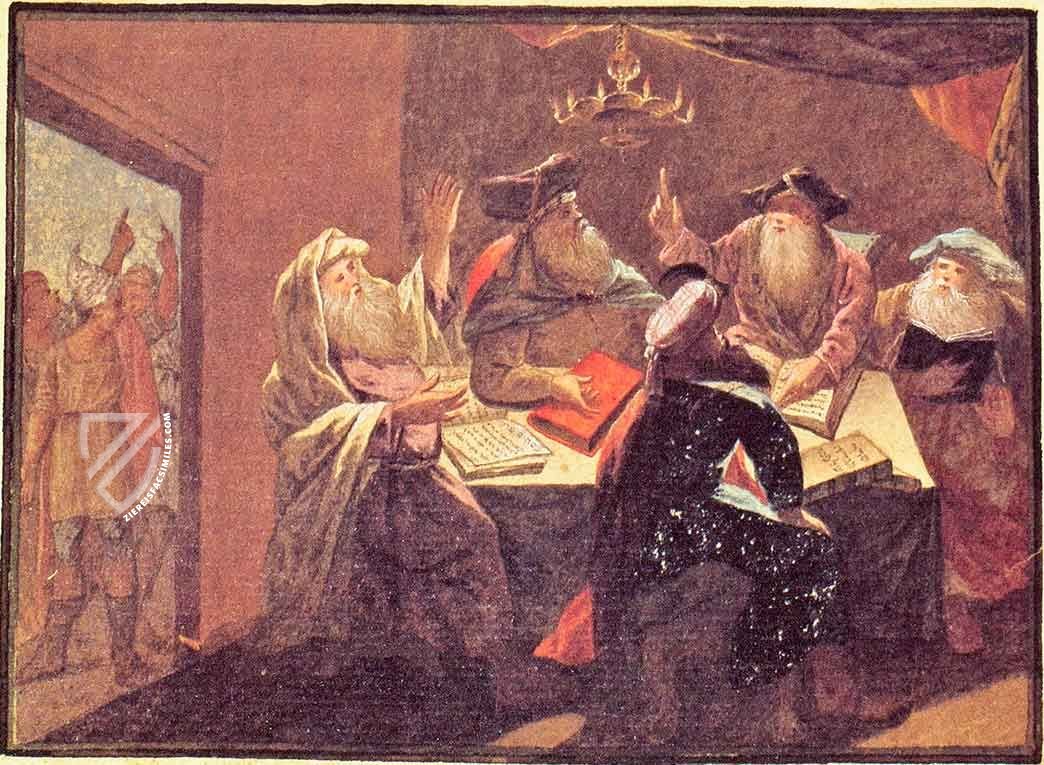
Darmstadt Pessach Haggadah - Codex Orientalis 7
The Four Sons
In the traditional Haggadah text, there are four sons who ask four questions about the Seder. The “wise son”, depicted on the right as a scholar, tries to truly understand the ritual so he can perform it one day. To his left is the “wicked son”, garishly dressed as a soldier, a common way of depicting the son who represents those who have become isolated from Judaism.
The “simple son” is dressed in black with sagging socks, a floppy hat with a white feather, and a walking stick, but is immediately identifiable by the idiotic look on his face. On the far left, the “son who does not know to ask is depicted” as a blond, pink-cheeked child dressed in a green coat. He looks out at the beholder as he plays innocently with his toy, unable to pay attention.
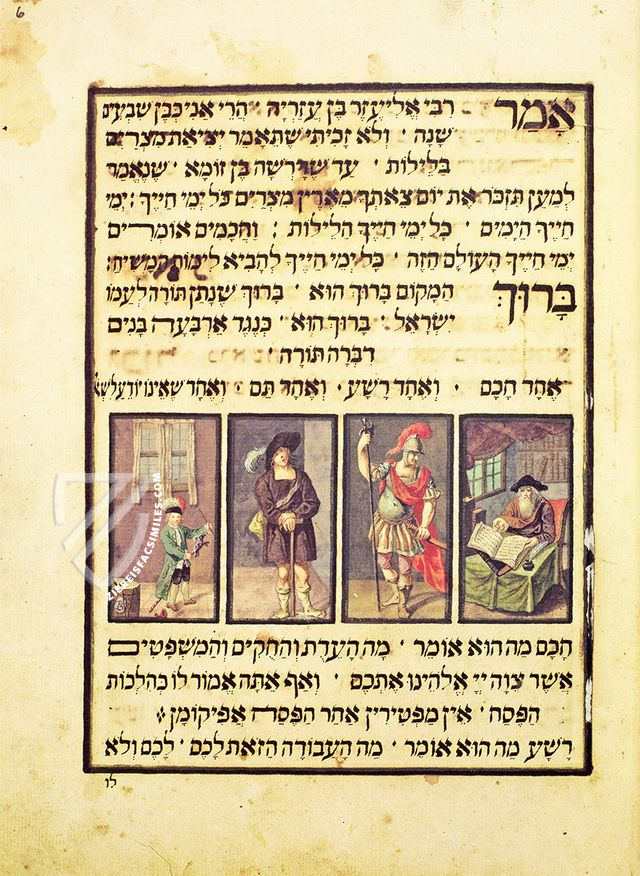
#1 Pessach-Haggadah
Language: English
The scholarly commentary by Ulf Haxen is in English and provides an introduction to the historic background of the manuscript. It also explains the significance of the author and painter of the manuscript for the history of art, describing every single page separately.
(1,000€ - 3,000€)
- Treatises / Secular Books
- Apocalypses / Beatus
- Astronomy / Astrology
- Bestiaries
- Bibles / Gospels
- Chronicles / History / Law
- Geography / Maps
- Saints' Lives
- Islam / Oriental
- Judaism / Hebrew
- Single Leaf Collections
- Leonardo da Vinci
- Literature / Poetry
- Liturgical Manuscripts
- Medicine / Botany / Alchemy
- Music
- Mythology / Prophecies
- Psalters
- Other Religious Books
- Games / Hunting
- Private Devotion Books
- Other Genres
- Afghanistan
- Armenia
- Austria
- Belgium
- Belize
- Bosnia and Herzegovina
- China
- Colombia
- Costa Rica
- Croatia
- Cyprus
- Czech Republic
- Denmark
- Egypt
- El Salvador
- Ethiopia
- France
- Germany
- Greece
- Guatemala
- Honduras
- Hungary
- India
- Iran
- Iraq
- Israel
- Italy
- Japan
- Jordan
- Kazakhstan
- Kyrgyzstan
- Lebanon
- Liechtenstein
- Luxembourg
- Mexico
- Morocco
- Netherlands
- Palestine
- Panama
- Peru
- Poland
- Portugal
- Romania
- Russia
- Serbia
- Spain
- Sri Lanka
- Sweden
- Switzerland
- Syria
- Tajikistan
- Turkey
- Turkmenistan
- Ukraine
- United Kingdom
- United States
- Uzbekistan
- Vatican City
- A. Oosthoek, van Holkema & Warendorf
- Aboca Museum
- Ajuntament de Valencia
- Akademie Verlag
- Akademische Druck- u. Verlagsanstalt (ADEVA)
- Aldo Ausilio Editore - Bottega d’Erasmo
- Alecto Historical Editions
- Alkuin Verlag
- Almqvist & Wiksell
- Amilcare Pizzi
- Andreas & Andreas Verlagsbuchhandlung
- Archa 90
- Archiv Verlag
- Archivi Edizioni
- Arnold Verlag
- ARS
- Ars Magna
- ArtCodex
- AyN Ediciones
- Azimuth Editions
- Badenia Verlag
- Bärenreiter-Verlag
- Belser Verlag
- Belser Verlag / WK Wertkontor
- Benziger Verlag
- Bernardinum Wydawnictwo
- BiblioGemma
- Biblioteca Apostolica Vaticana (Vaticanstadt, Vaticanstadt)
- Bibliotheca Palatina Faksimile Verlag
- Bibliotheca Rara
- Boydell & Brewer
- Bramante Edizioni
- Bredius Genootschap
- Brepols Publishers
- British Library
- C. Weckesser
- Caixa Catalunya
- Canesi
- CAPSA, Ars Scriptoria
- Caratzas Brothers, Publishers
- Carus Verlag
- Casamassima Libri
- Centrum Cartographie Verlag GmbH
- Chavane Verlag
- Christian Brandstätter Verlag
- Circulo Cientifico
- Club Bibliófilo Versol
- Club du Livre
- CM Editores
- Collegium Graphicum
- Collezione Apocrifa Da Vinci
- Comissão Nacional para as Comemorações dos Descobrimentos Portugueses
- Coron Verlag
- Corvina
- CTHS
- D. S. Brewer
- Damon
- De Agostini/UTET
- De Nederlandsche Boekhandel
- De Schutter
- Deuschle & Stemmle
- Deutscher Verlag für Kunstwissenschaft
- DIAMM
- Droz
- E. Schreiber Graphische Kunstanstalten
- Ediciones Boreal
- Ediciones Grial
- Ediclube
- Edições Inapa
- Edilan
- Editalia
- Edition Deuschle
- Edition Georg Popp
- Edition Leipzig
- Edition Libri Illustri
- Editiones Reales Sitios S. L.
- Éditions de l'Oiseau Lyre
- Editions Medicina Rara
- Editorial Casariego
- Editorial Mintzoa
- Editrice Antenore
- Editrice Velar
- Edizioni Edison
- Egeria, S.L.
- Eikon Editores
- Electa
- Emery Walker Limited
- Enciclopèdia Catalana
- Eos-Verlag
- Ephesus Publishing
- Ernst Battenberg
- Eugrammia Press
- Extraordinary Editions
- Fackelverlag
- Facsimila Art & Edition
- Facsimile Editions Ltd.
- Facsimilia Art & Edition Ebert KG
- Faksimile Verlag
- Feuermann Verlag
- Folger Shakespeare Library
- Franco Cosimo Panini Editore
- Friedrich Wittig Verlag
- Fundación Hullera Vasco-Leonesa
- G. Braziller
- Gabriele Mazzotta Editore
- Gebr. Mann Verlag
- Gesellschaft für graphische Industrie
- Getty Research Institute
- Giovanni Domenico de Rossi
- Giunti Editore
- Graffiti
- Grafica European Center of Fine Arts
- Guido Pressler
- Guillermo Blazquez
- Gustav Kiepenheuer
- H. N. Abrams
- Harrassowitz
- Harvard University Press
- Helikon
- Hendrickson Publishers
- Henning Oppermann
- Herder Verlag
- Hes & De Graaf Publishers
- Hoepli
- Holbein-Verlag
- Houghton Library
- Hugo Schmidt Verlag
- Idion Verlag
- Il Bulino, edizioni d'arte
- ILte
- Imago
- Insel Verlag
- Insel-Verlag Anton Kippenberger
- Instituto de Estudios Altoaragoneses
- Instituto Nacional de Antropología e Historia
- Introligatornia Budnik Jerzy
- Istituto dell'Enciclopedia Italiana - Treccani
- Istituto Ellenico di Studi Bizantini e Postbizantini
- Istituto Geografico De Agostini
- Istituto Poligrafico e Zecca dello Stato
- Italarte Art Establishments
- Jan Thorbecke Verlag
- Johnson Reprint Corporation
- Josef Stocker
- Josef Stocker-Schmid
- Jugoslavija
- Karl W. Hiersemann
- Kasper Straube
- Kaydeda Ediciones
- Kindler Verlag / Coron Verlag
- Kodansha International Ltd.
- Konrad Kölbl Verlag
- Kurt Wolff Verlag
- La Liberia dello Stato
- La Linea Editrice
- La Meta Editore
- Lambert Schneider
- Landeskreditbank Baden-Württemberg
- Leo S. Olschki
- Les Incunables
- Liber Artis
- Library of Congress
- Libreria Musicale Italiana
- Lichtdruck
- Lito Immagine Editore
- Lumen Artis
- Lund Humphries
- M. Moleiro Editor
- Maison des Sciences de l'homme et de la société de Poitiers
- Manuscriptum
- Martinus Nijhoff
- Maruzen-Yushodo Co. Ltd.
- MASA
- Massada Publishers
- McGraw-Hill
- Metropolitan Museum of Art
- Militos
- Millennium Liber
- Müller & Schindler
- Nahar - Stavit
- Nahar and Steimatzky
- National Library of Wales
- Neri Pozza
- Nova Charta
- Oceanum Verlag
- Odeon
- Orbis Mediaevalis
- Orbis Pictus
- Österreichische Staatsdruckerei
- Oxford University Press
- Pageant Books
- Parzellers Buchverlag
- Patrimonio Ediciones
- Pattloch Verlag
- PIAF
- Pieper Verlag
- Plon-Nourrit et cie
- Poligrafiche Bolis
- Presses Universitaires de Strasbourg
- Prestel Verlag
- Princeton University Press
- Prisma Verlag
- Priuli & Verlucca, editori
- Pro Sport Verlag
- Propyläen Verlag
- Pytheas Books
- Quaternio Verlag Luzern
- Reales Sitios
- Recht-Verlag
- Reichert Verlag
- Reichsdruckerei
- Reprint Verlag
- Riehn & Reusch
- Roberto Vattori Editore
- Rosenkilde and Bagger
- Roxburghe Club
- Salerno Editrice
- Saltellus Press
- Sandoz
- Sarajevo Svjetlost
- Schöck ArtPrint Kft.
- Schulsinger Brothers
- Scolar Press
- Scrinium
- Scripta Maneant
- Scriptorium
- Shazar
- Siloé, arte y bibliofilia
- SISMEL - Edizioni del Galluzzo
- Sociedad Mexicana de Antropología
- Société des Bibliophiles & Iconophiles de Belgique
- Soncin Publishing
- Sorli Ediciones
- Stainer and Bell
- Studer
- Styria Verlag
- Sumptibus Pragopress
- Szegedi Tudomànyegyetem
- Taberna Libraria
- Tarshish Books
- Taschen
- Tempus Libri
- Testimonio Compañía Editorial
- Thames and Hudson
- The Clear Vue Publishing Partnership Limited
- The Facsimile Codex
- The Folio Society
- The Marquess of Normanby
- The Richard III and Yorkist History Trust
- Tip.Le.Co
- TouchArt
- TREC Publishing House
- TRI Publishing Co.
- Trident Editore
- Tuliba Collection
- Typis Regiae Officinae Polygraphicae
- Union Verlag Berlin
- Universidad de Granada
- University of California Press
- University of Chicago Press
- Urs Graf
- Vallecchi
- Van Wijnen
- VCH, Acta Humaniora
- VDI Verlag
- VEB Deutscher Verlag für Musik
- Verlag Anton Pustet / Andreas Verlag
- Verlag Bibliophile Drucke Josef Stocker
- Verlag der Münchner Drucke
- Verlag für Regionalgeschichte
- Verlag Styria
- Vicent Garcia Editores
- W. Turnowski Ltd.
- W. Turnowsky
- Waanders Printers
- Wiener Mechitharisten-Congregation (Wien, Österreich)
- Wissenschaftliche Buchgesellschaft
- Wissenschaftliche Verlagsgesellschaft
- Wydawnictwo Dolnoslaskie
- Xuntanza Editorial
- Zakład Narodowy
- Zollikofer AG

